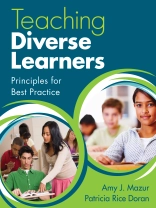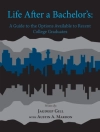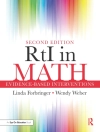‘This book is a useful text for districts trying to understand their ELL populations and for mainstream teachers trying to help their ELL students.’
—Faith Chaney, ESOL Teacher
Hickory Hills Middle School, Springfield, MO
‘A realistic guide to providing better educational opportunities for all in a diverse world. By addressing special or exceptional needs, cultural diversity, and general education populations across multiple disciplines, the book reaches out in ways not previously attempted.’
—Robert H. Williams, Jr.
Associate Professor of English
Radford University
Practical guidelines and strategies for meeting the needs of every student in your classroom!
Based on current research, legislation, and best practices for the classroom, this user-friendly guide offers a comprehensive overview of everything teachers need to know to differentiate instruction for students who are culturally and linguistically diverse, as well as those who have or might have special education needs.
Amy J. Mazur and Patricia Rice Doran present strategies, case studies, guiding questions, extensions, and ready-to-use activities to make critical information accessible to busy Pre K–12 teachers. The book helps educators:
- Understand key concepts, policies, and cultural issues for working with diverse learners
- Set up an effective, emotionally safe classroom
- Get to know students and their needs and strengths
- Adapt curriculum, instruction, and assessment to make learning accessible
- Collaborate with fellow professionals, families, and communities
By putting the vital information in this book into practice, teachers can meet the various needs of today′s diverse classrooms and ensure academic success for all their learners!
Tabella dei contenuti
Acknowledgments
About the Authors
Introduction
1. Who Are Our Diverse Learners? New Definitions, New Responses
2. The Impact of the Law: Policies and Diversity
3. What a Difference a Room Makes: Classroom Setup and Management for Learning
4. Really Seeing Your Students: The Importance of Behavioral Observation
5. Mental Wellness and Students′ Resiliency: Making School an Emotionally Safe Place
6. Curriculum and Language: Making Texts and Materials Accessible
7. Literacy Development: Factors Impacting Diverse Learners
8. Assessment: How Do You Know What Your Students Know?
9. Collaboration: Working Together for Student Success
10. Family Involvement: Forming Rich and Lasting Partnerships
References
Index
Circa l’autore
Amy J. Mazur, Ed.D., lead faculty in bilingual special education and a professor at the George Washington University, has been involved in teacher preparation for over 30 years. She has long been an advocate for the minority student who, as a result of poverty, health and developmental issues, immigrant status, or level of English language acquisition, has not been provided access to appropriate educational service delivery. Dr. Mazur has served as the chair of the Special Education Special Interest Group of the National Association for Bilingual Education (NABE); and she has been a member of the editorial staff of the Division for Culturally and Linguistically Diverse Exceptional Learners (DDEL), a division of the Council for Exceptional Children. Throughout her career, Dr. Mazur has presented at national and international conferences, advocating for the rights of minority students as well as the skills needed to prepare professionals to teach to the needs of all students. She lives in Washington, D.C., and is the mother of two children, Arin and Adam, both of whom have been an inspiration to her as she seeks to promote social justice and equity.












